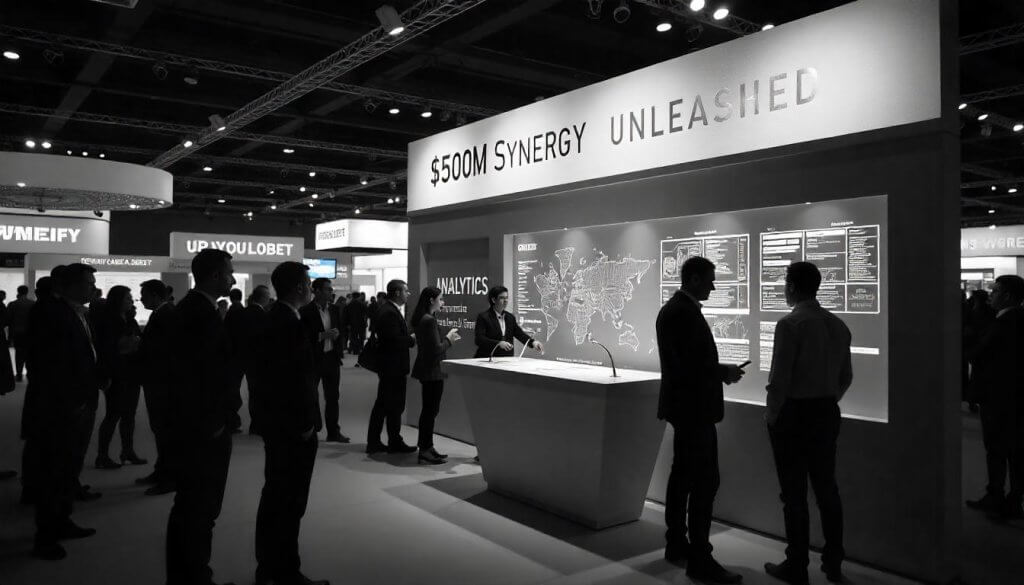The enterprise software sector thrives on innovation and scale, and a $500 million enterprise software merger between two industry players, which we’ll call “TechSync” and “CloudCore,” has redefined the landscape. This strategic deal, finalized in 2024, combined TechSync’s AI-driven analytics with CloudCore’s cloud infrastructure, unlocking powerful synergies. By aligning complementary strengths, the enterprise software merger fueled growth and innovation. This article explores the deal’s structure, the integration process, and its implications for the enterprise software industry.
The Mechanics of an Enterprise Software Merger
An enterprise software merger involves combining two companies to enhance capabilities, reduce costs, or expand market share. Unlike acquisitions, mergers emphasize partnership, aligning complementary technologies or customer bases. For enterprise software firms, mergers often aim to integrate platforms, streamline operations, and accelerate product development, leveraging recurring revenue models.
The TechSync-CloudCore merger was orchestrated by investment banks, including Morgan Stanley, and valued at $500 million. The deal leveraged TechSync’s $120 million ARR and CloudCore’s $100 million ARR, creating a combined entity with a $1.5 billion valuation. By merging, the companies aimed to dominate the enterprise software market, projected to reach $1 trillion by 2030.
The $500 Million Enterprise Software Merger
TechSync, known for AI analytics, and CloudCore, a leader in cloud orchestration, merged to create a unified platform for enterprise clients. Both companies faced competitive pressures from giants like Salesforce and needed scale to innovate. The enterprise software merger addressed these challenges, combining TechSync’s 5,000 clients with CloudCore’s 3,000, and targeting a 25% ARR increase within two years.
Structuring the Merger Deal
The $500 million merger was an all-stock transaction, with TechSync shareholders owning 55% of the new entity and CloudCore’s owning 45%. The deal included $50 million in cash to balance equity stakes, funded by a debt facility from JPMorgan Chase. The combined entity, rebranded as “SyncCore Solutions,” maintained co-CEOs from both firms to ensure balanced leadership. The structure aligned incentives, leveraging a 4:1 LTV-to-CAC ratio and 90% retention across both companies.
Driving Synergies Through Integration
SyncCore allocated $100 million to integration efforts, focusing on three areas. First, $40 million unified their platforms, creating a seamless AI-cloud solution that reduced client onboarding time by 30%. Second, $30 million consolidated operations, merging data centers to save $10 million annually. Finally, $30 million expanded sales teams, targeting enterprises in Asia and Europe. These efforts aimed to achieve $50 million in cost synergies and $75 million in revenue synergies by 2026.
Why Enterprise Software Mergers Thrive
Enterprise software’s recurring revenue and tech-driven nature make it ideal for mergers. Let’s examine why this strategy excels in the sector.
Complementary Technology Stacks
Merging complementary platforms, like TechSync’s AI and CloudCore’s cloud, creates integrated solutions. SyncCore’s unified platform addressed client demand for end-to-end software, increasing cross-selling by 20%. Consequently, enterprise software mergers enhance product offerings without heavy R&D costs.
Economies of Scale
Mergers reduce redundant costs, such as duplicate data centers or marketing. SyncCore’s operational consolidation cut expenses by 15%, freeing capital for innovation. This scalability allows merged firms to compete with larger players like SAP, which holds 12% of the market.
Expanded Market Reach
Combining customer bases broadens market access. SyncCore’s 8,000 clients spanned diverse industries, from healthcare to finance, boosting ARR potential. Moreover, the merger enabled entry into high-growth markets like Asia, where enterprise software spending is projected to grow 8% annually.
How the Merger Transformed SyncCore Solutions
The $500 million enterprise software merger reshaped SyncCore’s operations and competitive positioning, delivering measurable results.
ابتكار المنصة الموحدة
The $40 million platform integration created a flagship product combining AI analytics and cloud orchestration. This solution reduced client processing times by 25%, attracting Fortune 500 clients like a global retailer, which increased ARR by 10%. By unifying technologies, SyncCore set a new standard for enterprise software.
مكاسب الكفاءة التشغيلية
The $30 million operational consolidation streamlined data centers and back-office functions, saving $10 million annually. This efficiency enabled SyncCore to reinvest in R&D, launching a generative AI module that boosted user engagement by 15%. As a result, the merger enhanced profitability and innovation.
التوسع في الأسواق العالمية
The $30 million sales investment targeted Asia and Europe, securing 1,000 new clients within nine months. SyncCore localized its platform with multilingual support and regional compliance, driving 30% revenue growth in these markets. This global push positioned SyncCore as a top-tier enterprise software provider.
Market Impact of the $500 Million Merger
The enterprise software merger influenced the broader industry, shaping trends and competition.
Accelerating Consolidation
The SyncCore deal fueled a wave of enterprise software mergers, with $15 billion in deals in 2024, up 10% from 2023. Firms like ServiceNow ($2 billion merger with Celonis) followed suit, consolidating to counter giants like Microsoft. This trend is concentrating market share among integrated players.
جذب ثقة المستثمرين
SyncCore’s 50% valuation increase post-merger drew $250 billion in private capital to enterprise software. Investors like Thoma Bravo launched $500 million funds, citing SyncCore’s $125 million synergy target. This capital influx is empowering mid-sized firms to scale through mergers.
Driving AI-Cloud Integration
The merger’s AI-cloud platform set a benchmark, pushing competitors like Workday to invest in similar integrations. With 60% of enterprises adopting AI-driven software by 2025, per Gartner, this trend is reshaping the industry, enhancing automation and analytics.

Lessons for Enterprise Software Firms Pursuing Mergers
SyncCore’s merger offers actionable insights for enterprise software companies seeking similar strategies.
Align Complementary Strengths
The merger succeeded by combining TechSync’s AI with CloudCore’s cloud expertise. Firms should prioritize partners with complementary technologies or markets to maximize synergies and client value.
Prioritize Integration Planning
SyncCore’s $100 million integration budget ensured seamless execution. Companies must allocate resources for platform unification and operational alignment to achieve cost and revenue synergies.
تحسين المقاييس المالية
Investors valued SyncCore’s 4:1 LTV-to-CAC ratio and high retention. Firms should maintain strong metrics, like a net dollar retention rate above 120%, to justify merger valuations and attract financing.
Focus on Customer Retention
The merger retained 90% of clients through proactive communication and unified support. Firms must prioritize client experience during integration to prevent churn and sustain revenue.
استهداف الأسواق ذات النمو المرتفع
SyncCore’s Asia-Europe focus tapped into booming regions. Companies should target markets with strong enterprise software demand, like Asia’s 8% growth rate, to drive post-merger growth.
Challenges of Enterprise Software Mergers
Mergers pose risks. Integration costs, like SyncCore’s $100 million, can strain finances if synergies underperform. Cultural clashes between TechSync and CloudCore required mediation to align teams. Additionally, customer overlap risks churn if platforms aren’t seamlessly unified. Firms must address these challenges to ensure merger success.
The Future of Mergers in Enterprise Software
SyncCore’s $500 million enterprise software merger highlights the strategy’s potential. With the market projected to reach $1 trillion by 2030, driven by AI and cloud adoption, mergers will accelerate. Trends like low-code platforms and embedded AI will spur consolidation, while private equity will fund deals. As enterprise software evolves, mergers like SyncCore’s will drive innovation and market leadership.
الخاتمة
The $500 million enterprise software merger transformed SyncCore Solutions, unlocking $125 million in synergies through platform innovation, operational efficiency, and global expansion. By aligning complementary strengths and prioritizing integration, SyncCore set a benchmark for the industry. Its success offers a roadmap, emphasizing alignment, metrics, and customer focus. As mergers reshape enterprise software, deals like this will propel the next wave of growth and innovation.



التعليقات